Sony 24-70mm F/28 G Oss Lens Review Dx
Sony Fe 28-70mm F3.five-five.half-dozen OSS Lens Review

At review time, the 28-70mm f/3.v-5.six OSS Lens is the second to the lowest degree expensive Sony Iron lens available. Low price is a feature that anybody can become behind and a useful general-purpose focal length range, OSS, weather sealing, light weight, and meaty size are more than features that all will appreciate. Is this lens'south image quality proficient enough? That's what I wanted to know — let's find out.
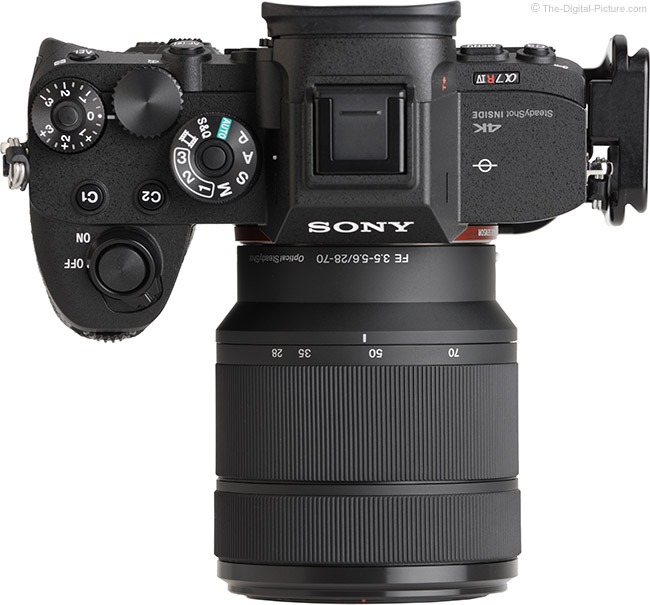
Focal Length Range
A primary lens selection feature should be the focal length or focal length range. Zoom lenses have a great advantage over prime lenses in this regard and the 28-70mm focal length range contained in this lens covers a huge range of needs, making it a bang-up general-purpose choice.
This is a peachy focal length range for photographing people and it is ideal for portraits, weddings, parties, events, documentaries, interviews, lifestyle, theater, fashion, studio portraiture, candids, and some sports (all when adequate lighting is available — more most this later). Use 70mm for head and shoulders portraits and the wider end for groups and environmental imagery. This focal length range is a perfect pick for media and photojournalistic needs.
This range is a good pick for landscape photography with compositions ideally captured using every focal length bachelor in this lens. The 28mm terminate is not especially wide simply information technology can create compelling wide-angle landscape compositions, providing accent on a foreground subject area against an in-focus groundwork with the viewer feeling a sense of presence in the scene. At the other finish of the range, 70mm works great for mildly-compressed landscapes featuring distant subjects such as mountains remaining large.
This focal length range is well-suited for commercial photography and is ready to capture some compages, cities, country sides, flowers, medium and big products, and much more.
Here is an example of what this focal length range looks like (borrowed from another 28-70mm lens review):

Many alternative standard zoom lenses offer 24mm on the broad end and I do miss this focal length sometimes, especially when photographing landscape. Here is a 24mm vs. 28mm comparison:

APS-C sensor format cameras utilize a smaller portion of the image circle and that means a scene is framed tighter with one.5x being the angle of view equivalence multiplier for Sony'due south lineup. With an angle of view similar to a 41-105mm lens on a full-frame camera, this lens has increased potential for portraiture and other brusk telephoto needs while the wide-bending uses are essentially erased.
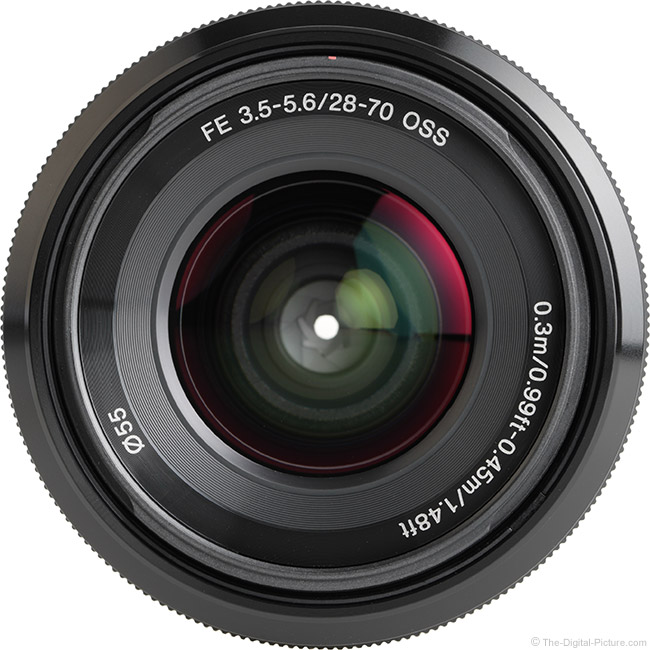
Max Aperture
This lens is very minor and low-cal merely it is not very brilliant. The f/3.5-5.half-dozen in the name refers to the maximum discontinuity, the ratio of the focal length to the diameter of the archway pupil, available in this lens. Wider apertures (lower numbers) are always better to have available — until the price, size, and weight penalties are factored in. To keep those factors peculiarly low, many zoom lenses contain a variable max aperture design. A relatively narrow variable max aperture is what the Sony Atomic number 26 28-70mm f/three.five-5.six OSS Lens has.
Here is this lens' max discontinuity stride downward past focal length:
28-30mm = f/three.5
31-40mm = f/4.0
41-51mm = f/iv.5
52-60mm = f/v.0
61-70mm = f/5.6
While the f/iii.five aperture at the wide end is reasonably wide, few 28mm lenses do non open to at to the lowest degree f/iv and, as is oftentimes the case with similar lenses, f/3.v is only available for a very short 3mm range. Positive is that the narrowest max aperture does not kicking in until 61mm. These max apertures brand this lens a poor choice for low light activeness such every bit indoor sports without wink (as a principal light/overpowering ambient lite) existence involved. Those following the old "f/8 and be there" rule and those photographing outdoors under direct sunlight will have the necessary apertures bachelor for well-nigh uses. When recording video, only 1/lx second shutter speeds (twice recording framerate) are typically needed (assuming yous're non capturing high framerate slow-motion video) and wide apertures are not frequently required for 1/60 2nd rates in usually encountered ambient lighting.
A downside to the variable max discontinuity is that, by definition, the same max aperture cannot be used over the unabridged focal length selected. The camera automatically accounts for the changes when in auto exposure modes, but making use of the widest-bachelor discontinuity in manual exposure mode is complicated somewhat by the changing setting.
Another disadvantage of narrow max discontinuity lenses is that they are less-able to strongly blur the groundwork. While this lens does non have the broad-aperture advantage, the 70mm end has enough telephoto length to create a squeamish amount of blur.

The to a higher place examples, captured at this lens's minimum focus distance, illustrate the maximum groundwork blur this lens can produce.

Paradigm Stabilization
Sony marketing touts its cameras as having IBIS (In-Body Image Stabilization), but many of their lenses also characteristic OSS (Optical SteadyShot). While perhaps not immediately articulate, these two stabilization systems are complementary: "v-axis image stabilization becomes available when used with α series bodies that feature congenital-in image stabilization." [Sony]
While narrow apertures may not be optimal under low light atmospheric condition, this lens' optical epitome stabilization organisation can relieve the day in such conditions, significantly increasing the versatility of this lens, improving usability and, in many situations, considerably improving the image quality delivered.
While OSS is great for reducing photographic camera milkshake-caused blur in images, information technology is as well very helpful for precise framing of subjects in the viewfinder. While OSS is active, drifting of framing is pocket-sized with the viewfinder view remaining well-controlled and subject reframing being easily achieved.
This OSS arrangement is essentially silent. Handheld video recording is nicely assisted by OSS and the stabilized composition besides provides a all the same subject to the photographic camera's AF system, permitting information technology to do its job better.
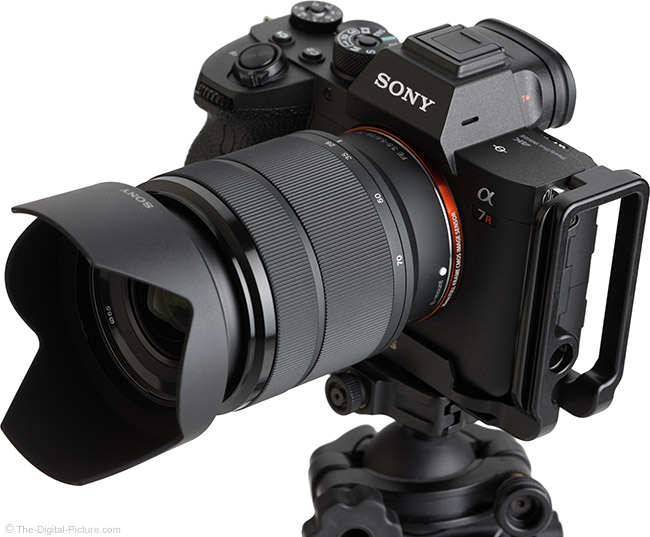
Epitome Quality
I know, subsequently I told you that this was the second least expensive Sony Atomic number 26 lens available, you were dreading this section of the review. Every lens gets an equal chance — permit'south see what this lens's results wait similar.
Lenses typically perform all-time in the center of the image circle and this lens creates decent center sharpness with the 70mm results lagging a chip. Piddling center-of-the-frame improvement is seen when stopping downwardly.
In general, lenses are not as sharp in the periphery where light rays must exist bent more strongly than they are in the center. This lens's results in the mid and outer portions of the frame are soft at the widest apertures. Stopping downwards past more than 1 terminate brings about a noticeable improvement in these areas though results are still just OK at f/eleven.
Below you will find sets of 100% resolution heart of the frame crops captured in uncompressed RAW format using a Sony a7R IV. The images were processed in Capture One using the Natural Clarity method with the sharpening amount set to but "30" on a 0-m scale. Annotation that images from most cameras require some level of sharpening but too-loftier sharpness settings are destructive to image details and hide the deficiencies of a lens.
Today we're going to demonstrate focus shift (residual spherical abnormality or RSA). In some lens designs, the airplane of precipitous focus can move frontwards or backward every bit a narrower aperture is selected. Nearly Sony lenses are either designed to non have focus shift or they are designed to right for it automatically. This one checks neither of those boxes and the event is very obvious. When testing lenses, we establish focus at the widest aperture (shallowest depth of field) and apply manual focus to ensure that the aforementioned focus distance is used to capture the unabridged aperture serial. The results of this practice with this lens are every bit shared below.

The wide-open results announced decent. Especially in the Norway spruce example, the plane of sharp focus tin be shifting dramatically toward the forepart at narrower apertures. What nosotros learn here is that when using this lens, focus must be established at the discontinuity being used for the exposure.
Next, nosotros'll expect at a comparison showing 100% extreme-top-left-corner crops captured and candy identically to the above center-of-the-frame images. These images were manually focused in the corner of the frame (at the widest aperture).
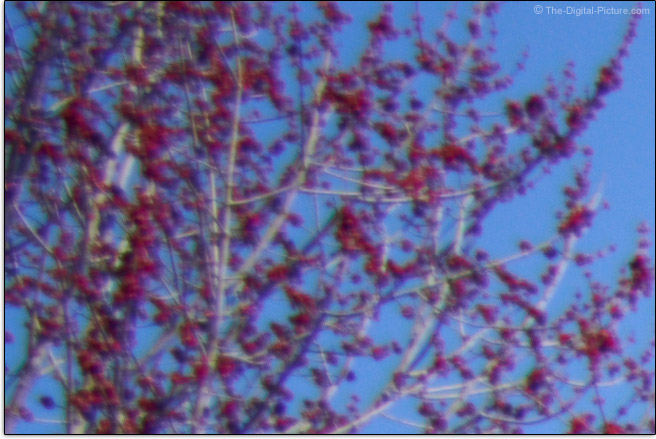
A very narrow discontinuity is required for decent corner sharpness when using this lens. Corner sharpness does not e'er matter merely it does matter for many disciplines including mural photography and architecture.
Lenses project a circle of light onto the image sensor. The physical properties of light passing through a lens make information technology impossible for the same corporeality of light to achieve the edges of the circle as the center, resulting in a darkening of the corners, referred to as vignetting or peripheral shading. Though this lens does non take especially wide apertures, the amount of peripheral shading at wide-open apertures is not peculiarly strong. Expect about 2.5 stops of shading at 28mm with the amount progressively reducing until about 1.six stops remains in the 70mm corners. Of course, the maximum aperture is also progressively reducing and at f/5.6, the 28mm corners show just 1.2 stops of shading. At f/eight, shading ranges from a only-sometimes-visible ane stop at 28mm to a very slightly higher 1.2 stops at 70mm.
APS-C format cameras using lenses projecting a total-frame-sized image circle avert most vignetting issues with this lens showing well under i stop of shading in the 28mm f/3.v corners.
The effect of different colors of the spectrum being magnified differently is referred to as lateral (or transverse) CA (Chromatic Aberration). Lateral CA shows as color fringing forth lines of potent dissimilarity running tangential (meridional, right angles to radii) with the mid and specially the periphery of the paradigm circumvolve showing the greatest amount as this is where the greatest difference in the magnification of wavelengths typically exists.
With the right lens profile and software, lateral CA is ofttimes easily correctable (often in the camera) by radially shifting the colors to coincide though it is e'er better to not have the trouble in the showtime place. Any color misalignment present can easily exist seen in the site's paradigm quality tool, but allow's also look at a set up of worst-example examples, 100% crops from the extreme elevation left corner of a7R III frames showing diagonal black and white lines.

In that location should be merely black and white colors in these images and the boosted colors are showing the presence of lateral CA. The colour separation at 28mm and 35mm is moderately strong (even in the mid-frame area) and the separation at the longer focal lengths is less just still noticeable.
A relatively common lens aberration is axial (longitudinal, bokeh) CA, which causes non-coinciding focal planes of the various wavelengths of light, or more but, different colors of light are focused to different depths. Spherical abnormality forth with spherochromatism, or a change in the amount of spherical aberration with respect to color (looks quite like to axial chromatic aberration only is hazier) are other common lens aberrations to look for. Centric CA remains at least somewhat persistent when stopping downward with the color misalignment event increasing with defocusing while the spherical abnormality color halo shows lilliputian size change as the lens is defocused and stopping downwards one to two stops mostly removes this aberration.
In the real world, lens defects do not be in isolation with spherical aberration and spherochromatism generally institute, at least to some degree, along with axial CA. These combine to create a less sharp, hazy-appearing image quality at the widest apertures.
In the examples below, look at the fringing colors in the out of focus specular highlights created by the neutrally-colored subjects. Whatsoever color divergence is existence introduced by the lens.

Peculiarly at the wide terminate, this lens is creating some colour is these test results.
Flare and ghosting are caused by bright light reflecting off of the surfaces of lens elements, resulting in reduced contrast and sometimes-interesting artifacts. When used at a wide aperture, this lens does not show significant flaring in our testing with the sun in the corner of the frame. Stop down modestly to f/8 and very destructive flaring becomes nowadays despite the low lens element count (9 elements in eight groups). Results worsen at narrower apertures.
Ii lens aberrations that are especially evident when shooting images of stars, mainly because bright points of lite confronting a dark background make them easier to come across. Blackout occurs when light rays from a point of light spread out from that signal, instead of existence refocused as a indicate on the sensor. Blackout is absent in the heart of the frame, gets worse toward the edges/corners, and generally appears as a comet-similar or triangular tail of light which can be oriented either away from the center of the frame (external blackout), or toward the center of the frame (internal coma). Coma clears as the aperture is narrowed. Astigmatism is seen every bit points of light spreading into a line, either sagittal (radiating from the center of the prototype) or meridional (tangential, perpendicular to sagittal). Recollect that lateral CA is another abnormality apparent in the corners.
The images below are 100% crops taken from the pinnacle-left corner of a7R Iii frames.

These results are not optimal.
At 28mm, this lens shows moderately stiff barrel distortion. Past 35mm, the barrel distortion has transitioned into very slight pincushion distortion and by 50mm and through 70mm, the pincushion distortion is quite strong. Most modernistic lenses have lens correction profiles available for the pop paradigm processing software and baloney can be hands removed using these, but distortion correction is destructive at the pixel level. Some portion of the image must exist stretched or the overall dimensions must be reduced.
The amount of blur a lens can produce is piece of cake to show (and was shown earlier in the review). Assessing the quality is a much harder claiming due in part to the space number of variables present in all bachelor scenes. Following are some f/11 (for aperture blade interaction) examples.

The first set of results shows how defocused highlights are rendered. These results are reasonably nice. The second prepare of results was captured outdoors and again, they expect reasonably dainty.
Except for a small number of specialty lenses, the wide aperture bokeh in the corner of the frame does not produce round defocused highlights with these furnishings taking on a true cat's eye shape due to a course of mechanical vignetting. If you await through a tube at an bending, similar to the low-cal reaching the corner of the frame, the shape is not circular and that is the shape seen here. Hither are the wide-open results from this lens.
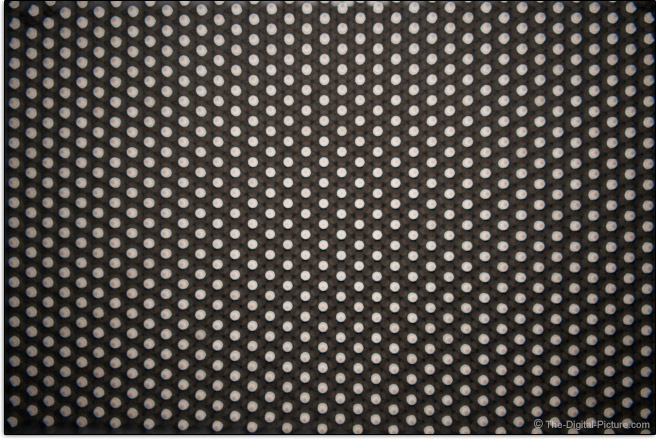
As the discontinuity narrows, the entrance student size is reduced and the mechanical vignetting absolves with the shapes condign circular.
With a 7-bract count aperture, indicate light sources captured with a narrow aperture setting and showing a sunstar upshot will have 14 points. In full general, the more a lens is stopped downwardly, the larger and meliorate-shaped the sunstars tend to be.

The examples to a higher place were captured at f/16. A narrow max aperture lens does not beget much stopping downwards before reaching apertures where diffraction causes noticeable softening of details and these lenses typically exercise not produce the biggest or all-time-shaped sunstars.

The pattern of this lens is illustrated above. Purple indicates aspherical elements, designed to reduce astigmatism, field curvature, coma, and other monochromatic aberrations, and an ED element, designed to reduce chromatic aberrations and color fringing, is shown in green.
Overall, this lens is a mediocre performer in regards to image quality.

Focusing
The Sony Atomic number 26 28-70mm f/3.five-5.6 OSS Lens utilizes a linear motor for focusing.
This lens internally focuses very quietly with good speed. Every bit expected for a narrow aperture lens, low light AF is non a specialty and hunting tin be expected at times when lighting and contrast are not strong.
This lens does non feature the AF concur button mutual on Sony lenses. FTM (Full Time Manual) focusing is supported via Sony's DMF (Direct Manual Focus) AF mode.

Normal is for the scene to change size in the frame (sometimes significantly) as focus is pulled from 1 extent to the other, referred to as focus animate, a change in focal length resulting from a change in focus distance. Focus breathing negatively impacts photographers intending to utilise focus stacking techniques, videographers pulling focus, and anyone very-critically framing a scene while adjusting focus. This lens shows a moderate change in field of study size as full extent focus adjustments are fabricated as illustrated beneath.

The reviewed lens does non appear to be parfocal. Refocusing should be washed after zooming in or out.

The FE 28-70 features a forrard-positioned (as I prefer) rubber-ribbed manual focus ring that works nicely. The ring is not huge, but information technology is properly sized for the corporeality of space available on the lens barrel.
This is a multi-speed focus ring. Turn information technology quickly for a full extent change in virtually 45° or plough it slowly for several full rotations of aligning (I kept losing my focus when trying to turn the band around that many times). I generally prefer a linear response adjustment but this multi-speed implementation has non bothered me (which is usually the real test).
With an 11.viii" (300mm) minimum focus distance, the Sony Atomic number 26 24-240mm f/iii.5-half-dozen.3 OSS Lens creates an upward to 0.19x maximum magnification.
| Model | MFD | MM | |
| Sony Iron 24-70mm f/2.8 GM Lens | 15.0" | (380mm) | 0.24x |
| Sony FE 24-70mm f/4 ZA OSS Lens | 15.vii" | (400mm) | 0.20x |
| Sony Fe 24-105mm f/4 G OSS Lens | fifteen.0" | (380mm) | 0.31x |
| Sony FE 24-240mm f/3.5-6.3 OSS Lens | 19.7" | (500mm) | 0.27x |
| Sony Iron 28-70mm f/3.v-5.6 OSS Lens | 11.viii" | (300mm) | 0.19x |
| Tamron 28-75mm f/2.eight Di III RXD Lens | 7.five" | (190mm) | 0.34x |
A 0.19x maximum magnification is not amazing but it is useful. At 70mm, a subject measuring approximately 6.iv 10 4.iii" (163 x 109mm) volition fill up the frame at the minimum focus distance.

Demand a shorter minimum focus distance and greater magnification? An extension tube mounted backside this lens should provide a very significant subtract and increase respectively. Extension tubes are hollow lens barrels that shift a lens farther from the camera, which permits shorter focusing distances at the expense of long-distance focusing. Electronic connections in extension tubes permit the lens and camera to communicate and otherwise function equally normal. Sony does not publish extension tube specs nor do they industry these items, but third-party Sony extension tubes are available.
This lens is not compatible with Sony teleconverters.

Build Quality & Features
The Sony Atomic number 26 28-70mm f/three.5-5.6 OSS Lens has a build quality that feels lower-end than most of the other Sony Iron lenses (and being very light in weight does not aid in that regard) but it seems reasonably well constructed.
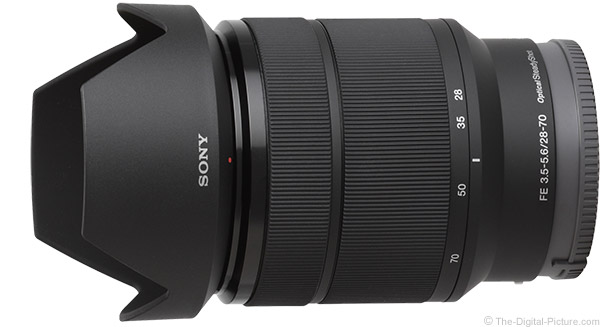
This lens extends and retracts modestly (0.3" / 8mm) when zooming with virtually 45mm existence the most-retracted position.
Most of the lens butt surface is condom-ribbed rings with the zoom ring being nicely-sized, smoothen, and without play.
There are no switches or buttons on this lens. Carte options are required to switch between AF and MF and to enable or disable OSS.

This is a grit and moisture resistant lens — not to exist confused with waterproof. Having that feature specified for a lens in this price range is very positive.
If yous have to carry a lens for long periods, sign up to carry this 1. Information technology is small-scale and extremely light.
| Model | Weight oz(one thousand) | Dimensions w/o Hood "(mm) | Filter | Year | ||
| Sony FE 24-70mm f/2.8 GM Lens | 31.3 | (886) | 3.4 x five.4 | (87.6 x 136.0) | 82 | 2016 |
| Sony Atomic number 26 24-70mm f/4 ZA OSS Lens | 15.2 | (430) | 2.9 x 3.7 | (73.0 10 94.5) | 67 | 2014 |
| Sony FE 24-105mm f/4 K OSS Lens | 23.iv | (663) | iii.3 10 4.5 | (83.iv ten 113.3) | 77 | 2017 |
| Sony FE 24-240mm f/3.v-6.3 OSS Lens | 27.v | (780) | three.ii x iv.7 | (80.5 x 118.5) | 72 | 2015 |
| Sony Atomic number 26 28-70mm f/3.5-5.6 OSS Lens | 10.four | (295) | 2.nine x 3.iii | (72.5 x 83.0) | 55 | 2013 |
| Tamron 28-75mm f/2.8 Di Three RXD Lens | nineteen.4 | (550) | 2.9 ten four.6 | (73.0 ten 117.eight) | 67 | 2018 |
For many more comparisons, review the complete Sony Iron 28-70mm f/3.5-5.six OSS Lens Specifications using the site'southward lens specifications tool.
Here is a visual Comparison:

Positioned above from left to right are the post-obit lenses:
Sony Fe 28-70mm f/3.5-v.half-dozen OSS Lens
Sony FE 24-70mm f/4 ZA OSS Lens
Sony Fe 24-240mm f/3.five-half dozen.3 OSS Lens
Canon RF 24-240mm F4-vi.3 IS USM Lens
Sony Iron 24-70mm f/ii.8 GM Lens
The same lenses are shown below with their hoods in place.
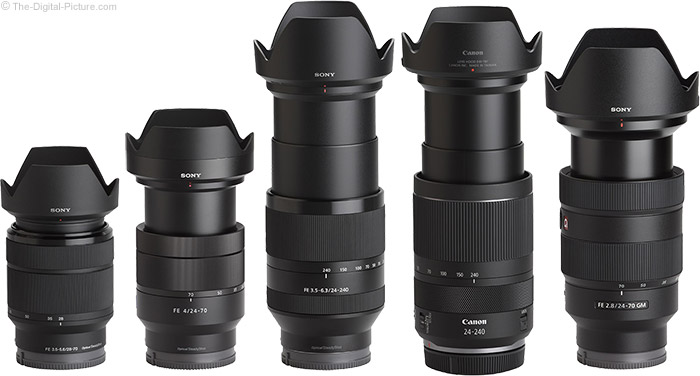
Use the site's product paradigm comparing tool to visually compare the Sony FE 28-70mm f/3.five-v.vi OSS Lens to other lenses.
This lens accepts 55mm threaded filters. While this size is non especially popular, information technology is very small and 55mm filters are relatively inexpensive.
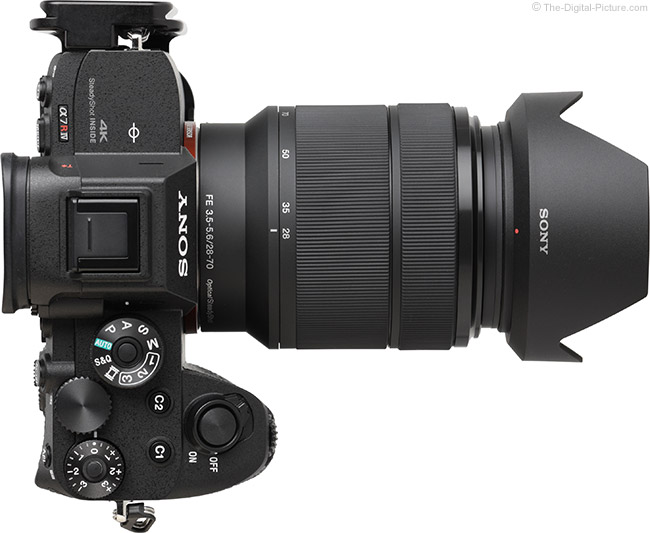
Sony includes the petal-shaped ALC-SH132 hood in the box. This is a semi-rigid plastic hood with a matte plastic interior. This bayonet-mount hood does not include a release button but smoothly snaps into place without pregnant effort. This hood is big enough to be protective, peculiarly on the peak and bottom.
A lens case is not included in the box, but finding a example for a common lens course factor is non challenging. Consider a Lowepro Lens Instance or Call back Tank Photo Lens Case Duo for a quality, affordable unmarried-lens storage, transport, and carry solution.
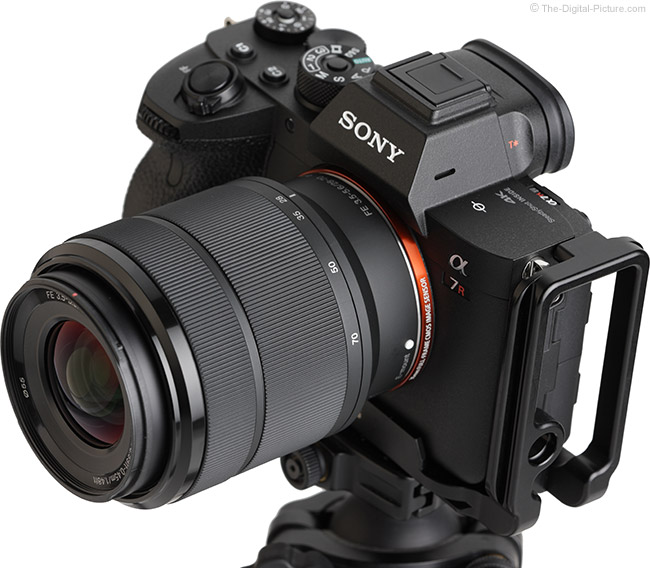
Toll, Value, Wrap Upward
When being evaluated for value, a lens starting with the second-lowest price in the FE lineup gives it a significant caput starting time over the competitors. While the paradigm quality delivered past the FE 28-70 is not stellar, information technology is hard to difficult about the value generated by the low price. The next-lowest-priced Sony Iron zoom lens, the Atomic number 26 24-70mm f/4 ZA OSS Lens, costs more than twice every bit much.
As an "Iron" lens, the Sony Iron 28-70mm f/three.5-5.6 OSS Lens is compatible with all Sony E-mount cameras, including both total-frame and APS-C sensor format models. Sony provides a 1-year limited warranty.
The reviewed Sony FE 28-70mm f/3.5-5.6 OSS Lens was online-retail sourced.

Alternatives to the Sony FE 28-70mm f/3.5-5.6 OSS Lens
Expected is that a full general-purpose lens has a broad range of comparable options. The closest Sony Atomic number 26 lens option is currently the Sony Iron 24-70mm f/4 ZA OSS Lens.
In the image quality comparison, we see the 24-70 ZA performing modestly better in the majority of the wide-open aperture comparisons. The 28-seventy has a wider aperture for a very minor range of wide-angle focal lengths and the 24-70 with its stock-still max discontinuity has the advantage over a more meaning range of longer apertures. At equal apertures, the 24-lxx ZA has a bigger advantage. Here is the 70mm comparing. At the same apertures, the 28-seventy has lens peripheral shading at the wide finish and the 24-70 has less at the long stop. The 24-70 ZA shows less lateral CA, shows less flare over most of the range, and shows more barrel distortion at the wide end.
Looking at the specs and measurements, the Sony Iron 28-70mm f/3.5-5.6 OSS Lens vs. Sony FE 24-70mm f/4 ZA OSS Lens comparing shows the 24-seventy weighing l% more than and measuring slightly longer. The 28-70 has 55mm filter threads vs. 67mm. The 24-70 has a amend build quality but costs roughly twice as much.
If looking for a bargain-priced Sony general-purpose lens, the Tamron 28-75mm f/two.8 Di III RXD Lens is definitely worth considering. While priced even a flake higher than the 24-70 f/iv, this Tamron lens is a very compelling choice. Loftier on the advantage listing is the Tamron lens'due south significantly wider max aperture over much of the range (the Sony lens'southward aperture opens 1/3 stop wider over a brusque range at the wide cease). The Tamron lens'southward up to 2-stop wider aperture allows up to 4x more than light transmission, a big advantage in low light, for stopping activity, and for blurring the background.
The image quality comparison shows the Tamron lens sharper at f/two.viii than the Sony lens fifty-fifty when stopped down. Advantaged by the wide max aperture, the Tamron lens has less peripheral shading at the Sony lens'southward widest apertures. While the Tamron lens shows some flare furnishings at narrow apertures, the Sony lens's flare effects are stronger and more destructive, despite the Tamron lens having a significantly higher lens count (15/12 elements/groups vs. 9/8). The Tamron lens has less geometric distortion, especially at the long end.
Looking at the specs and measurements, the Sony FE 28-70mm f/iii.5-5.half-dozen OSS Lens vs. Tamron 28-75mm f/ii.8 Di III RXD Lens comparison shows the Tamron lens's penalty for the wider aperture – heavier weight. While not a heavy lens, the Tamron 28-75 weighs nearly twice every bit much equally the lightweight Sony lens and the Tamron lens is besides a bit longer. The Tamron lens has 9 discontinuity blades vs 7 (the additional blades aid keep highlight mistiness circular in shape when the discontinuity is stopped down a greater corporeality). The Tamron lens has 67mm filter threads vs. 55mm (67mm is more mutual only 55mm is smaller). The Tamron lens has a significantly greater maximum magnification (0.34x vs. 0.19x). The Tamron lens has a six-year Us warranty vs. 1. The price is the Sony lens'due south primary advantage.
Use the site's epitome quality comparing tools to create additional comparisons.

Summary
The compact size, calorie-free weight, great general-purpose focal length range, and very low price are strong advantages of the Sony FE 28-70mm f/3.5-5.half dozen OSS Lens. Pulling this lens down to the middle of the Fe lens popularity ranks is the low-end image quality. In that regard, you get what you pay for. If your budget reaches no higher than this lens, go it and learn how to apply its strengths.
Bringing you this site is my total-time job (typically 60-80 hours per week). Thus, I depend solely on the commissions received from you using the links on this site to brand whatever buy. I am grateful for your back up! - Bryan
My Recommended Sony FE 28-70mm F3.5-five.6 OSS Lens Retailers
Rent the Sony FE 28-70mm F3.five-5.half-dozen OSS Lens
The Tip Jar
Bryan Recommends Buying It Hither
Source: https://www.the-digital-picture.com/Reviews/Sony-FE-28-70mm-f-3.5-5.6-OSS-Lens.aspx
0 Response to "Sony 24-70mm F/28 G Oss Lens Review Dx"
إرسال تعليق